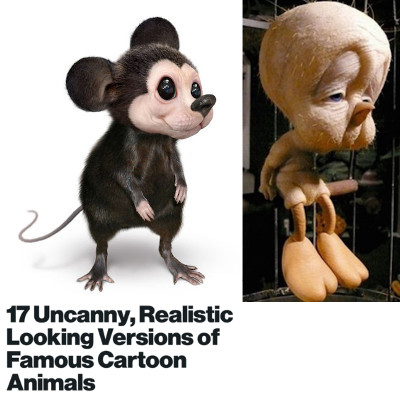
I have been thinking about the uncanny valley for decades. Here are some things I’ve written on the subject:
![]()
The Uncanny Valley of Expression
How Does Artificial Life Avoid the Uncanny Valley?
Over time, animated filmmakers have become more savvy about the uncanny problem. They are getting generally better at avoiding the creeps. According to this article, Disney learned its lesson, the hard way….
Despite the fact that animators are more savvy about the Valley, I still can’t help but notice a nagging, low-grade fever of optical realism that has crept into the lineup of popular animated characters (even as the accidental monsters get shuffled off to quarantine). Consumers of animated films may be unaware of it…because it has become normalized. The realism has increased, bit by bit, so that now we have quivering hair follicles, sparkling teeth, and eyeballs reflecting the light of the environment.
Imagine if our favorite classic characters were rendered like this.
But the discomfort we call the uncanny valley doesn’t only occur when the thin veneer of visual realism unexpectedly reveals a mindless robot where “nobody is home”. The phenomenon could be seen in a larger context: it is caused by the clash of any two aspects of an artificial character that operate at incompatible levels of realism. For instance…
Can Animals Become Too Human?
I recently saw Zootopia. I really enjoyed it. Great film. But I must say, I did catch a glimpse of the Valley. There’s no denying it.
I also recently saw Guardians of the Galaxy, with Rocket Raccoon, who exhibits two very different kinds of realism: (1) Raccoon! (2) A tough guy with attitude – and a very human intelligence.
 Can contradictory behavioral realism create a different sort of valley? Technology for character animation has enabled a much higher level of expressivity than has ever been possible, with fine detail in subtle eye and mouth movements. One might conclude that since behavioral realism has caught up with visual realism, the uncanny valley should now be a thing of the past. But then again, that depends on whether the behavior and the visuals apply to the same species!
Can contradictory behavioral realism create a different sort of valley? Technology for character animation has enabled a much higher level of expressivity than has ever been possible, with fine detail in subtle eye and mouth movements. One might conclude that since behavioral realism has caught up with visual realism, the uncanny valley should now be a thing of the past. But then again, that depends on whether the behavior and the visuals apply to the same species!
Nothing abnormal about a cartoony raccoon throwin’ shapes and talkin’ tough. But when this animal is rendered in a hyper-realistic manner, AND evoking high-res human expression, things start to feel odd.
 Pandas, ants, lobsters, bison, eels … in order for all of these various animals to assume the range of human emotion needed to deliver a clever line, they have to be equipped with a face with all the expected degrees of freedom. The result is what I call “rubber mask syndrome”.
Pandas, ants, lobsters, bison, eels … in order for all of these various animals to assume the range of human emotion needed to deliver a clever line, they have to be equipped with a face with all the expected degrees of freedom. The result is what I call “rubber mask syndrome”.

One example is the characters in Antz, whose faces stretch in very un ant-like ways in order to express very human-like things. More and more animals (unlikely animals even) are being added to the cast of movie stars. They are snarky, sly, witty, sexy, clever…and oh so human. It has all gotten a little weird if you ask me.


